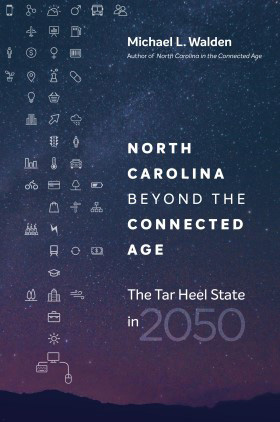What Will North Carolina’s Economy Look Like in 2050?

Today’s North Carolina bears little resemblance to the state we see on re-runs of the Andy Griffith Show. One reason for that is because Andy Griffith was, well, a TV show. But another reason is that North Carolina’s economy has undergone a sea change over the past 50 years. And that evolution is still under way.
The ongoing transformation of the North Carolina economy will likely mean big changes for everything from the state’s education system to the way it levies taxes. Everyone in the state, and I mean everyone, will be affected.
A new book from Michael Walden, North Carolina Beyond the Connected Age: The Tar Heel State in 2050, looks at all of the economic drivers that will play a role in shaping North Carolina over the coming decades – and what that will likely mean for North Carolina’s economy and institutions.
We talked with Walden, an economist at NC State and regular columnist on economic issues, about what the future holds for the Old North State.
The Abstract: What are the key questions you’re trying to address with North Carolina Beyond the Connected Age?

Michael Walden: The book’s goal is to answer several basic questions, all centered around expected changes in North Carolina to mid-century: how will our population change and where will people live, what economic sectors will drive North Carolina’s future economy; what kinds of jobs will people have; how will education and training have to adapt; what are the potential impacts of global warming and will we have enough natural resources for 3.4 million more people in 2050, and what changes in taxes and public spending will be needed to keep up with our evolving economy?
TA: Why write this book now? To put it another way, what is North Carolina going through that makes now the right time to address these questions?
Walden: Uneven economic growth in the state, widening income inequality, a declining middle class, the expanding scope and capabilities of technology, and the threat of technological unemployment in the labor market are all now known features of our current economy and society both in the nation and North Carolina. Each of these elements raises serious questions about how our state is changing. The book is a natural result of attempting to ascertain how these features – as well as others – will shape our state in the future. And, in particular, if our state is being shaped in some detrimental ways, what accommodations can we begin now to address these forces.
TA: In the book, you talk about human capital (i.e., the workforce) and about which sectors of the workforce will thrive or decline. What are some of the core ideas you want to convey here?
 Walden: First, that the job market will continue to change, with many existing jobs being downsized while new occupations are created, and these shifts may occur much more rapidly than in the past. Second, that economists are not completely capable of predicting declining and expanding occupations. Therefore, third, educational institutions need to be flexible and ready to redeploy resources to new and expanding fields of study while contracting resources to fields that are shrinking.
Walden: First, that the job market will continue to change, with many existing jobs being downsized while new occupations are created, and these shifts may occur much more rapidly than in the past. Second, that economists are not completely capable of predicting declining and expanding occupations. Therefore, third, educational institutions need to be flexible and ready to redeploy resources to new and expanding fields of study while contracting resources to fields that are shrinking.
TA: What role can, or should, policy makers play in putting North Carolinian workers in the best position to flourish under those circumstances?
Walden: The most important role of the public sector will be in funding a public educational system – all the way from pre-K to four year colleges and universities and beyond – that quickly adapts to the changing labor market. There also needs to be a renewal of funding and support for high school and community college training in technical and vocational fields, where many jobs now go unfilled due to a lack of qualified applicants. Third, there should be an expectation that an entire new group of students will emerge in the future who will need to have their training “renewed” as a result of technology overtaking their former occupations. Many of these “renewal students” will be in their 30s, 40s, and 50s.
TA: You devote a chapter to the role that the North Carolina government can play addressing the state’s future challenges. What are some of the crucial things you think state government will have to do – or avoid doing? To what extent do you think that will affect state government itself?
Walden: One of the biggest challenges of state government will be avoiding a “generational clash,” between funding for programs helping young individuals (mainly education) and funding for programs assisting the growing elderly component of our population (mainly health care programs). Increasing the efficiency of publicly spent funds and substituting private funding for public funding are solutions the state will be forced to consider and evaluate.
Another challenge is the tax system. As the economy evolves, some elements of the state tax system will become inadequate. For example, electric vehicles will reduce gas tax receipts, which are the main source of transportation funding in the state. Also, the possibility of 3-D manufacturing moving the production of products out of factories and into homes could decimate sales tax receipts. In the book, I outline two alternative broad-base tax systems – one based on income and the other based on spending (consumption).
- Categories:


